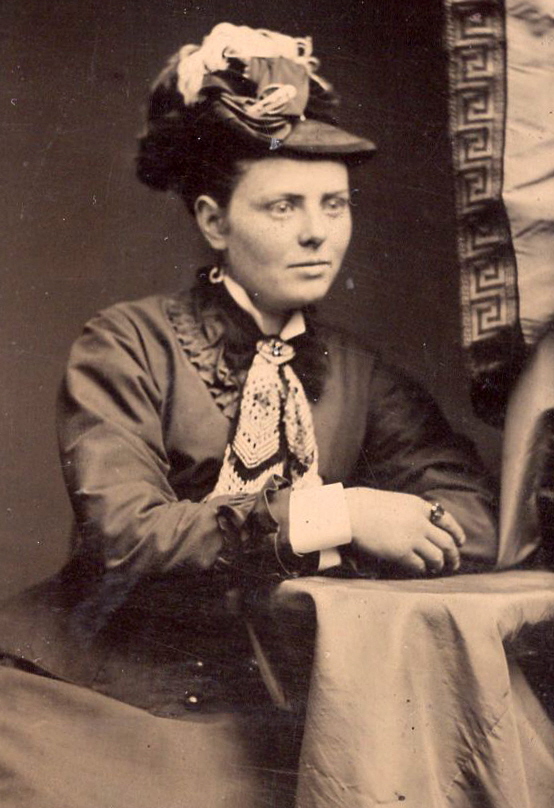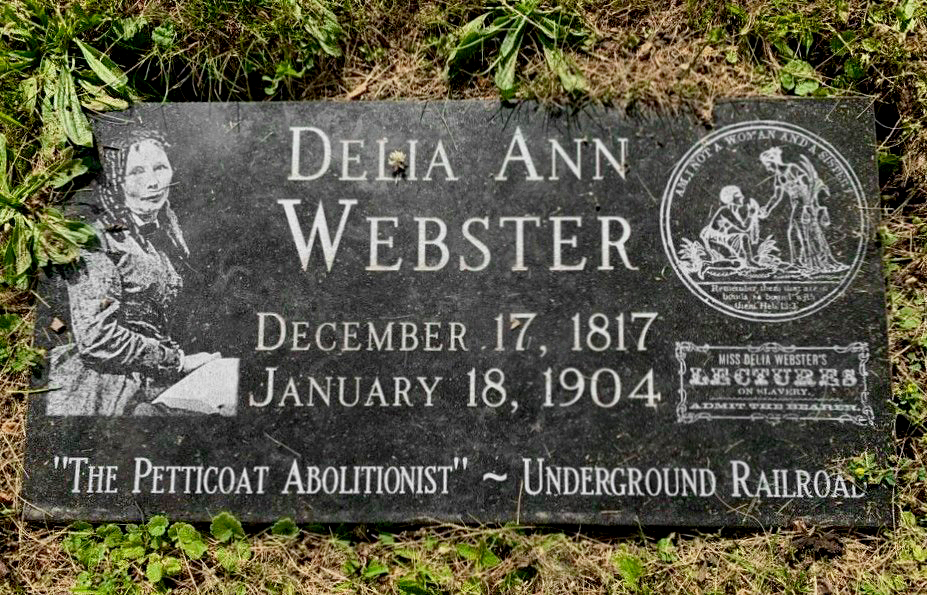 |
 |
|
Graphic Enterprises - Home of the Pioneer Times USA - A Web Site for Living History
|
 |
|
|
|
 |
|
 |
 |
|
|
 |
|
 |
 |
 |
 |
 |
 |
 |
 |
 |
 |
 |
 |
|
 |
|
|
|
A Modern Look at a 19th Century Abolitionist
Part II: A Descendant’s View of
Delia Webster
By Helen E. McKinney
|
|
|
|
|
|
When the Civil War ended and slavery was finally abolished, Delia Ann Webster became an obscurity. She had been run out of Trimble Co., Kentucky and lived the rest of her life quietly with relatives who seemed to be the only individuals who knew what remarkable work she had accomplished.
But there are many who, 117 years after her death in January 1904, remember Webster for her abolitionist work. In 2020, Joyce Loftus and her husband John of Seattle, Washington, embarked upon a pandemic project that had personal meaning to them and one in which they hope will have a lasting effect on future generations.
Their pandemic project was described on John’s Facebook page as a personal endeavor to, “Get a stone placed on the unmarked grave of my wife’s first cousin, four generations removed, 1800’s abolitionist Delia Ann Webster.” The result was an unforgettable journey of revelation.
|
|
|
|
|
 |
|
|
|
Webster was a first cousin to Joyce’s great-great grandmother, Charlotte Webster. Both women were born in 1817 and grew up as neighbors in Vergennes, Addison Co., Vermont during a time when the abolition of slavery was fast becoming the dominant issue in a young American nation.
|
|
|
|
|
|
|
Delia Webster, a newly discovered photo of Delia, circa 1858 (Photo courtesy of the Anita Balkovek collection, Redding, CA
|
|
|
|
|
|
|
|
|
|
“My great-great grandma Charlotte Webster was a daughter of John Champlain Webster, a younger brother of Delia’s father, Benajah,” said Joyce. “Both brothers were blacksmiths, a respected and essential occupation in those days, and Benajah was also a noted gunsmith.” Benajah married Ester Ann Bostwick, who would become Delia’s mother.
|
|
|
|
|
|
|
Joyce and John Loftus
|
|
|
|
 |
 |
|
Joyce said her mother’s Webster ancestors were a prominent Connecticut founding family. “Delia and I both descend from Gov. John Webster (1590-1661), an early governor of the colony. After the Revolution, like many others, a lot of Webster’s migrated northward to become early settlers of Vermont and New Hampshire.”
Joyce’s great-great-grandmother Charlotte “grew up very near to Rokeby Farm, well-known as a major station on the Underground Railroad. The whole area they grew up in was a hotbed of abolitionism.”
Delia and Charlotte’s lives would lead them down different paths, Delia to live as a national figure in the abolitionist movement and Charlotte to live a quite life in MN. Delia never married nor had children. In 1842, Charlotte married Edward Sumner and they had a daughter Armenia who eventually migrated to Crown Point, New York. “In 1857, they followed two of Charlotte’s married sisters to Winnebago City, Minnesota Territory,” said Joyce.
Charlotte’s two sisters married brothers with the last name Bigelow who became successful in gold mining at Sierra City, California. Her parents and daughter moved to Winnebago City and “I grew up on a small farm in Minnesota,” said Joyce.
When Edward Viall (Joyce’s grandfather in the Webster line) lost his wife to complications following childbirth in 1922, he was unable to take care of his large family of seven children, four under the age of ten. Joyce’s mom Bernice was one of them. The older children moved in with local families, while the four youngest, including Bernice (born 1912) were raised in the Odd Fellows Home in Northfield, Minnesota. Her infant brother was adopted.
“My mother didn’t talk about family history until she was quite advanced in age, and then she proved to be a very colorful storyteller about everything she had personally experienced,” said Joyce. This piqued her interest and led to the discovery of her connection to Delia Webster.
“I am quite interested in genealogy. My mother was passionate about preserving family history and lived to be 94. Whenever we visited her, we would try to have her identify old family pictures and tell us what she knew about ancestors,” said Joyce.
She was encouraged by her mother to look into the Webster line when her mother commented, “There is so much more in the Webster and Sumner lines that I don’t know about – if only you could look into them.” Although intrigued, Joyce was not able to do any research until after her mother passed away.
As is common among many families, nearly all of her mom’s descendants “are interested only in relatives that they knew and remembered. Their interest ends when the line extends to those they never met,” Joyce said. “My husband John and I were always interested in both history in general, as well as family history, and so she told us everything she knew about her family time and again in her waning years. John has worked with Native Americans all his life, and that is how they carry on their traditions – through repetition. If an elder tells you the same story they’ve told you before, it doesn’t matter that you’ve heard the story. That’s how you learn, and one day you will be the elder and the carrier of the stories, as I am now.”
“This became such a meaningful project as John and I read more and more about Delia,” Joyce said. While on their quest to learn more about Delia, John was able to locate a descendent of one of Charlotte Webster Sumner’s sisters. The relative, Anita Balkovek of Redding, CA, revealed she had a tintype photo that she believed to be of Delia in her younger days. So far, only one photo of Delia was known to exist - a group photo with her sisters taken sometime after the Civil War when Delia was older.
|
 |
 |
|
Charlotte Webster Sumner’s sister, Sarah Jane Webster Bigelow, kept a family album. In it was a tintype of a woman Balkovek presumed to be Delia Webster, taken around 1858. It may have been taken when Delia was marketing shares in her Webster Kentucky Farm Association venture to prominent Eastern investors in 1858, said John.
The tintype depicts a younger, more determined and dynamic Delia than is shown in the previously known photo taken with her sisters. In the later photo of Delia, her cheeks are hollow and deeply sunken due to loss of her back teeth, not uncommon in those days. Delia is seen wearing the same large ring in both photos. Sarah Jane was a great-great-grandaunt of Balkovek, who inherited Sarah Jane’s chest of photos, clippings and memorabilia, which she shared with the Loftus’s.
“The pictures that Anita sent were such a valued and poignant piece of personal family history. I had never seen a picture of my second great-grandmother Charlotte Webster Sumner before,” said Joyce. “As we found more information about Delia and unlocked a few more clues, it became essential to complete the project. We will continue searching family records, with the hope of finding more of Delia’s legacy. I would love to find some of her art work and learn more about her teaching days as well as her heroic abolitionist endeavors.”
When researching her Webster line, “we discovered Delia and the biographies that have fairly recently been written. It was fascinating to read about her and made me so proud; but we were surprised and dismayed that she did not have a marked grave,” she said.
This discovery sparked what Joyce called a “great experience.” She said providing a grave stone for Delia was something “we’d been wanting to get around to for several years.”
Due to COVID-19, the Loftus’ were unable to travel to the Woodland Cemetery in Des Moines, Iowa where Delia is buried to see the actual stone laid in place last year. Joyce said, “We did everything through email and snail mail correspondence” with the cemetery. “John designed the stone, which was purchased from Ohio-based Legacy Headstones and shipped to Des Moines.” A cemetery worker set the stone and provided them with a picture.
|
|
|
 |
|
|
 |
 |
 |
|
Delia Ann Webster Grave Marker, Woodland Cemetery, Des Moines, Iowa (Photo courtesy of Joyce and John Loftus)
|
 |
 |
|
The most definitive biography written to date on Webster is Delia Webster and the Underground Railroad. The biography was written by author and retired professor, Randolph Paul Runyon in 1996.
“I had for some time wanted to write a book on Kentucky history, and when I happened across Chapter Eight of J. Winston Coleman’s book Slavery Times in Kentucky, which tells Delia Webster’s story, I thought that if I could find any fresh information on her that might be a good book project,” Runyon said.
Beginning with the Coleman account, “I tracked down every 19th-century newspaper article I could find on Webster, Calvin Fairbank, Lewis Hayden, Newton Craig and related topics. This was more difficult in 1993 or so than it is now, since we didn’t have the Internet or newspapers on line where one can do a word search from the comfort of home.”
A retired French and French literature professor from Miami University in Oxford, Ohio, Runyon “grew up in Maysville, KY where Calvin Fairbank took Lewis Hayden across the Ohio River, and now lives in Paris, Kentucky where Delia passed through on the night of the Hayden rescue.”
“Webster was “a courageous fighter for freedom, but also a fascinating and at times puzzling personality.” he said. She was “a fearless, independent woman.”
|
|
|
 |
 |
|
“History needs to be preserved and historical figures are essential to that recording of history; they deserve to be memorialized,” Joyce said. “The experience of placing a stone for my husband’s grandmother (a few years previously) was such a fulfilling moment for celebrating a life that was somewhat lost after her death. I have visited the graves of my ancestors going back to the mid-1600’s in Boston and I find it very moving to place flowers and thank them for our history.”
The couple has also had the opportunity to visit the graves of some of Joyce’s famous, but more distant relations such as poet Emily Dickinson, a seventh cousin. “I have seen that their graves are much visited, and that people leave little items of tribute, such as, in Emily Dickinson’s case, pencils and scraps of paper with poems on them,” she said. “The Underground Railway has been gaining a rapidly growing tourism following. We have friends, often descendants of slaves, that make such pilgrimages, and we hope that soon the grave of Delia Webster will be added to their bucket lists.”
|
 |
 |
|
All of Joyce’s relatives still live in MN. “My grandniece in the Twin Cities area is also very interested in the history of Delia Webster and the abolitionist movement. Her 16-year-old daughter Terrynna, who is bi-racial, half black, was taught about Delia in history class at school awhile back and, having learned about her relationship with Delia from us, was extremely proud to be able to say she was her relative.”
Once COVID restrictions ease, Terrynna and her mother will be joining John and Joyce when they travel to Minnesota. The four of them will make the pilgrimage to Delia’s grave in Iowa together, the first time any of them will view the new gravestone. Terrynna has worked on a school project about her famous abolitionist relative, and “I think Delia would be thrilled if she could see her beautiful dark young first cousin, seven generations later, proudly telling her classmates about her life, her struggles, her courage, and her heroism. This seems like such a wonderful example of family history coming around in a full circle, and we look forward to making this family pilgrimage together.
|
|
|
 |
 |
|
A comparison photo of young and older Delia Webster (provided by John Loftus)
|
|
|
 |
 |
|
Charlotte Webster Sumner, Delia’s 1st cousin and Joyce Loftus’s g-g-grandmother (Photo courtesy of the Anita Balkovek collection, Redding, CA)
|
|
|
|
|